Having worked in the industrial ultrasonics / NDT industry (although it was about 30 years ago :) ), I will try to add to the excellent advice you have already received.
Kaz makes a very good point that you should use an oscilloscope. This is potentially a very difficult project and you need to do the necessary R&D on the ultrasonics before you do too much circuit design.
There are a couple problems with the 40khz transducers that you may or may not be able to overcome. First, as pointed out by Andy aka, the time for the ultrasonics to pass through the concrete is not much different from the period of a 40khz wave. You MAY be able to overcome this by measuring the phase of the received signal relative to the transmitted signal. Second, your transducers were likely designed to be used in air. Due to the large density change when the ultrasonic enters and exits the concrete, you will lose most of your signal due to reflections. There may not be enough signal at the receiver. Since this is probably your simplest solution, it is worth testing with an oscilloscope.
Now things get more complex. You may need a couplant other than air to lessen the density miss-match. The couplant is the medium between the transducers and the material being tested. If you can immerse your sample, water is probably the best choice. If you can't immerse the sample, you could possibly use grease, petroleum jelly, mineral oil or some type of gel (I knew an Ultrasonics Applications Engineer who swore by Dippity-Do hair gel, but I don't think that is made any more). Your 40khz transducers may not be compatible with couplants other than air. The fluid couplant must replace all the air between the surface of the transducer and the sample being tested.
Andy aka also made the suggestion of higher frequency transducers. You should be aware that when you get into the Mhz range, you will definitely need a couplant other than air because ultrasonics at these frequencies attenuate very quickly in air. I have been away from the business and am no longer familiar with transducer prices or sources, but Google will help with that. Edit: From additional research, I see that frequencies suitable for concrete inspection typically fall in the range of 24kHz to 200kHz (see "Additional Research" below).
These higher frequency transducers are typically pulsed with a very fast high voltage pulse, typically maybe 300V or more in < 10ns (the faster the better). This is typically achieved with a fast SCR or, depending on voltage, circuits involving multiple SCRs in series. It's kind of like ringing a bell with a hammer.
Regarding volocity measurement: If your transducers are not in contact with the sample, you will need to subtract the time of travel through the couplant (water or air or whatever). The speed of sound in the couplant can vary due to various factors (such as temperature and contaminants), so for best accuracy you can measure it without the concrete in place by knowing the separation betweeen the transducers. You then need to subtract the concrete thickness from the transducer separation to determine the distance traveled through the couplant, then knowing the distance through the couplant and the velocity of sound through the couplant, you can calculate the time spent traveling through the couplant.
Regarding your sample clock and your velocity measurement resolution: A technique used in the ultrasonics industry to "effectively" increase the resolution is to use separate asynchronous clocks. One clock to derive the trigger for your transmission pulse, and a different clock for the time measurement. You then take the average of many measurements. Of course if you only need 1μs resolution in your timer, this will not be necessary.
I just found Ultrasonic pulse velocity test of concrete on youtube. There is not much technical information on the ultrasonics themselves, but it may provide some useful information. There are also links to other related videos. I see they use direct contact between the transducers and the concrete recommending grease or petroleum jelly as a couplant.
The NDT Resource Center also has much useful information on ultrasonic testing.
Edit ... Additional Research:
According to Ultrasonic Low-Frequency Short-Pulse Transducers with Dry Point Contact.Development and Application.:
The ultrasonic testing of concrete and ferroconcrete is possible on the frequencies not more the 150 - 200 kHz.
This paper goes on to discuss a "Dry Point Contact" (DPC) transducer which apparently uses no couplant.
I don't know if you will find anything useful here, but it is good to know alternative approaches.
THE IMPROVEMENT OF ULTRASONIC APPARATUS FOR THE ROUTINE INSPECTION OF CONCRETE is a very informative paper on the subject. Of particular interest are:
- 2.3 Concrete and non-destructive inspection techniques (discusses various ultrasonic techniques and other alternative techniques)
- 2.4 The PUNDIT test equipment (discusses the blocks making up the design of the ultrasonic equipment used as well as the transducers used)
This paper also discusses the frequencies used for concrete testing:
Different sizes of piezo electric element and case enable a range of transducer centre frequencies from 24kHz to 200kHz suitable for testing of concrete.
Final Note: Since the use of expensive transducers and high-voltage pulsers may be outside of your budget in both time and money for a student project, If you don't mind risking a couple transducers on some R&D, I would suggest that you make some attempts at modifying some inexpensive 40kHz air transducers to allow the use of a couplant. Use through-transmission with direct contact on the concrete (of a known thickness), and see if you can receive a signal. There is much help on the web regarding circuits for these transducers. You might start at How to Wire Up Ultrasonic Transducer
